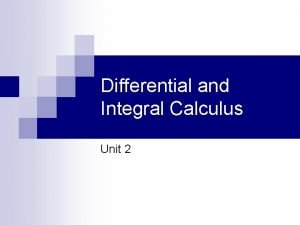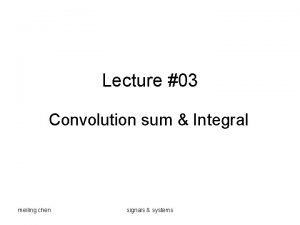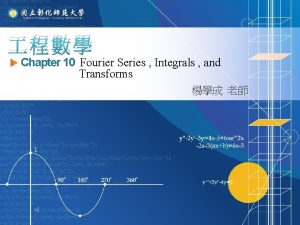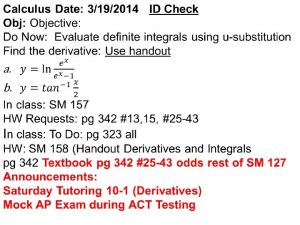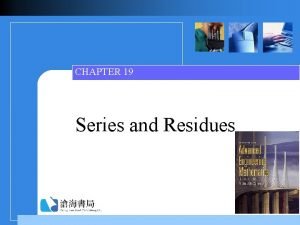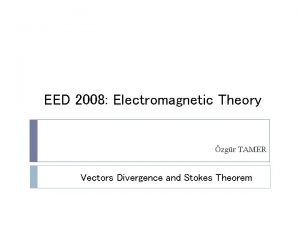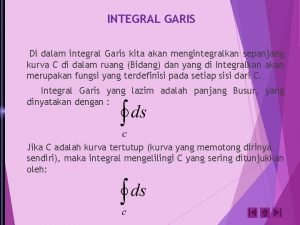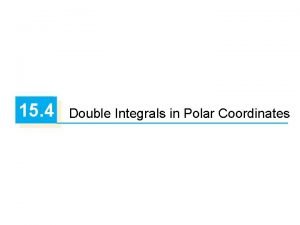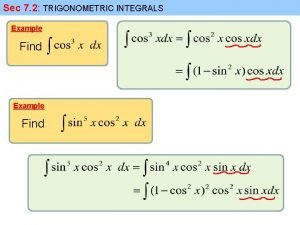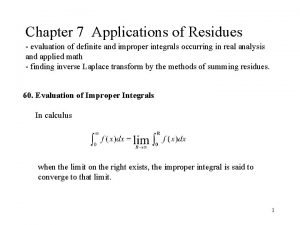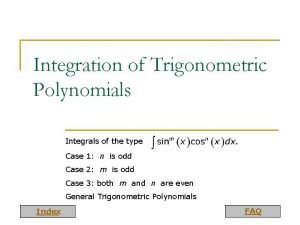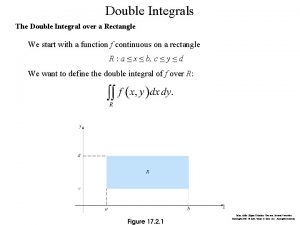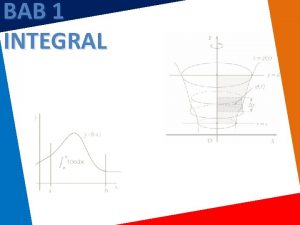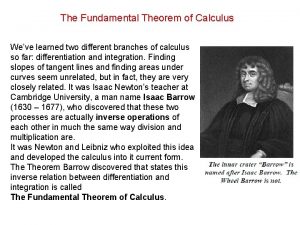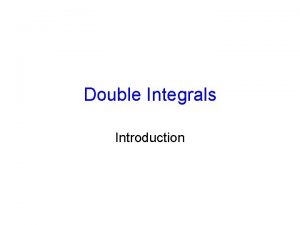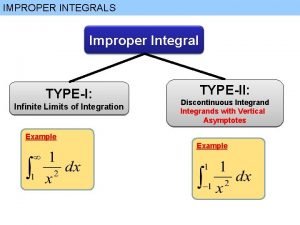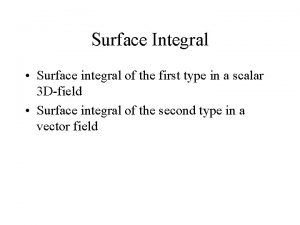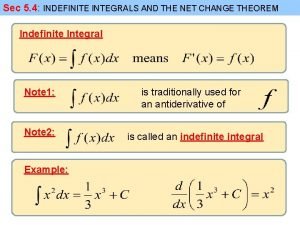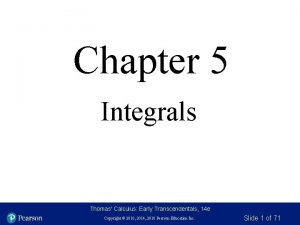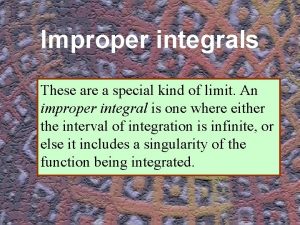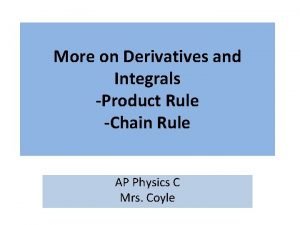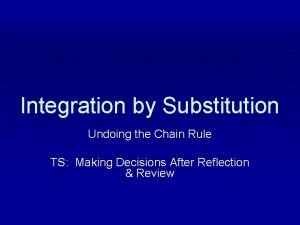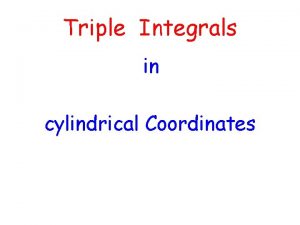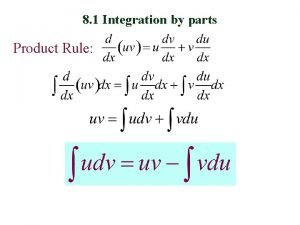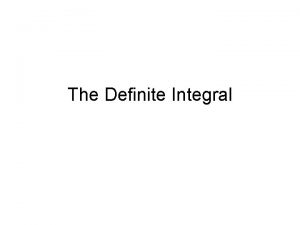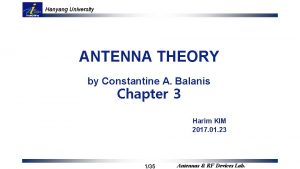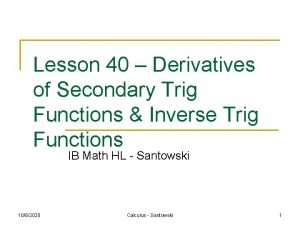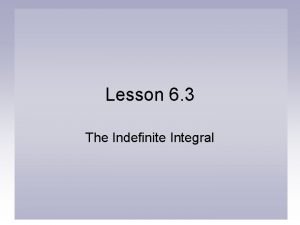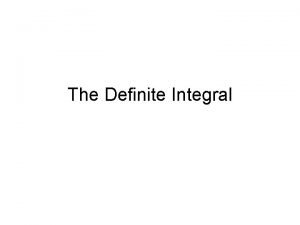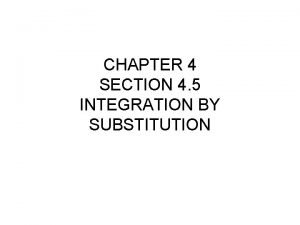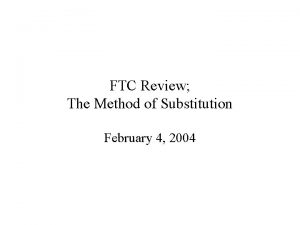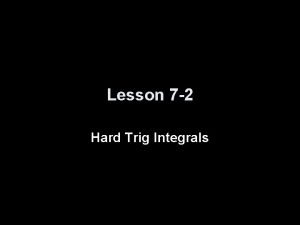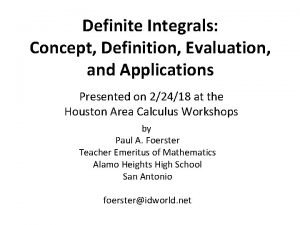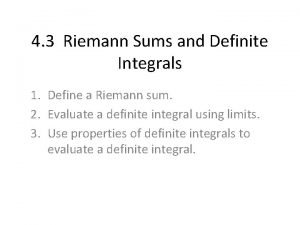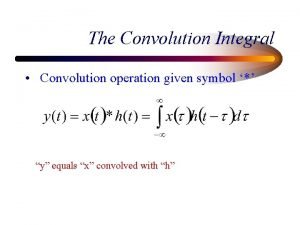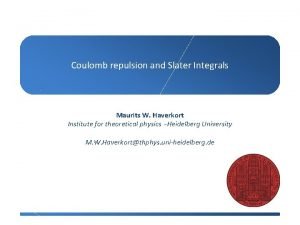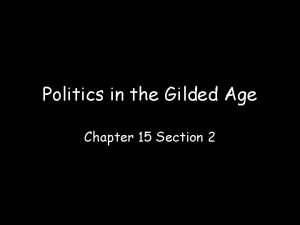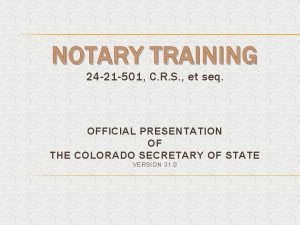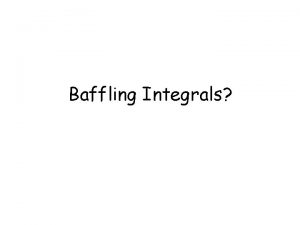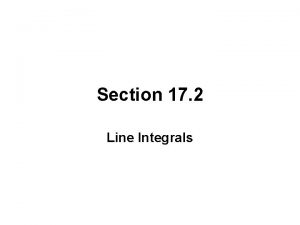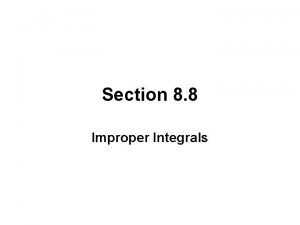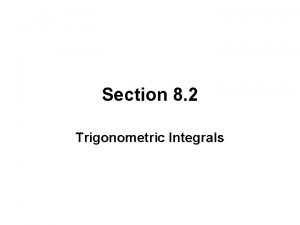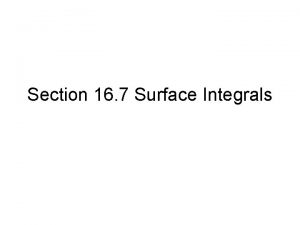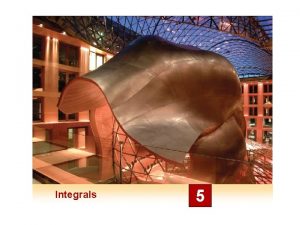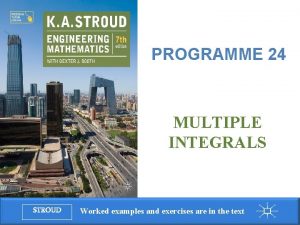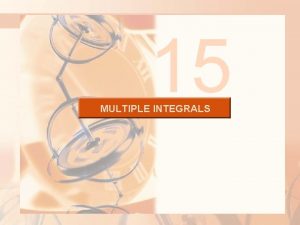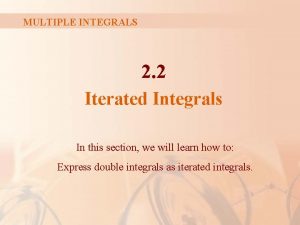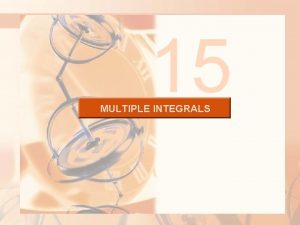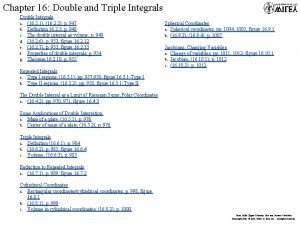5 INTEGRALS INTEGRALS In Section 5 3 we


























![APPLICATIONS The FTC 2 says that, if f is continuous on [a, b], then APPLICATIONS The FTC 2 says that, if f is continuous on [a, b], then](https://slidetodoc.com/presentation_image_h/9c3a0a1299ad4cecd8ac2dbff68f8d89/image-27.jpg)




 is the concentration of the product of a chemical NET CHANGE THEOREM If [C](t) is the concentration of the product of a chemical](https://slidetodoc.com/presentation_image_h/9c3a0a1299ad4cecd8ac2dbff68f8d89/image-32.jpg)




















- Slides: 52

5 INTEGRALS

INTEGRALS In Section 5. 3, we saw that the second part of the Fundamental Theorem of Calculus (FTC) provides a very powerful method for evaluating the definite integral of a function. § This is assuming that we can find an antiderivative of the function.

INTEGRALS 5. 4 Indefinite Integrals and the Net Change Theorem In this section, we will learn about: Indefinite integrals and their applications.

INDEFINITE INTEGRALS AND NET CHANGE THEOREM In this section, we: § Introduce a notation for antiderivatives. § Review the formulas for antiderivatives. § Use the formulas to evaluate definite integrals. § Reformulate the second part of the FTC (FTC 2) in a way that makes it easier to apply to science and engineering problems.

INDEFINITE INTEGRALS Both parts of the FTC establish connections between antiderivatives and definite integrals. § Part 1 says that if, f is continuous, then is an antiderivative of f. § Part 2 says that can be found by evaluating F(b) – F(a), where F is an antiderivative of f.

INDEFINITE INTEGRALS We need a convenient notation for antiderivatives that makes them easy to work with.

INDEFINITE INTEGRAL Due to the relation given by the FTC between antiderivatives and integrals, the notation ∫ f(x) dx is traditionally used for an antiderivative of f and is called an indefinite integral. Thus, ∫ f(x) dx = F(x) means F’(x) = f(x)

INDEFINITE INTEGRALS For example, we can write § Thus, we can regard an indefinite integral as representing an entire family of functions (one antiderivative for each value of the constant C).

INDEFINITE VS. DEFINITE INTEGRALS You should distinguish carefully between definite and indefinite integrals. § A definite integral is a number. § An indefinite integral ∫ f(x) dx is a function (or family of functions).

INDEFINITE VS. DEFINITE INTEGRALS The connection between them is given by the FTC 2. If f is continuous on [a, b], then

INDEFINITE INTEGRALS The effectiveness of the FTC depends on having a supply of antiderivatives of functions. § Therefore, we restate the Table of Antidifferentiation Formulas from Section 4. 9, together with a few others, in the notation of indefinite integrals.

INDEFINITE INTEGRALS Any formula can be verified by differentiating the function on the right side and obtaining the integrand. For instance,

TABLE OF INDEFINITE INTEGRALS Table 1

TABLE OF INDEFINITE INTEGRALS Table 1

INDEFINITE INTEGRALS Recall from Theorem 1 in Section 4. 9 that the most general antiderivative on a given interval is obtained by adding a constant to a particular antiderivative. § We adopt the convention that, when a formula for a general indefinite integral is given, it is valid only on an interval.

INDEFINITE INTEGRALS Thus, we write with the understanding that it is valid on the interval (0, ∞) or on the interval (-∞, 0).

INDEFINITE INTEGRALS This is true despite the fact that the general antiderivative of the function f(x) = 1/x 2, x ≠ 0, is:

INDEFINITE INTEGRALS Example 1 Find the general indefinite integral ∫ (10 x 4 – 2 sec 2 x) dx § Using our convention and Table 1, we have: ∫(10 x 4 – 2 sec 2 x) dx = 10 ∫ x 4 dx – 2 ∫ sec 2 x dx = 10(x 5/5) – 2 tan x + C = 2 x 5 – 2 tan x + C § You should check this answer by differentiating it.

INDEFINITE INTEGRALS Example 2 Evaluate § This indefinite integral isn’t immediately apparent in Table 1. § So, we use trigonometric identities to rewrite the function before integrating:

INDEFINITE INTEGRALS Example 3 Evaluate § Using FTC 2 and Table 1, we have: § Compare this with Example 2 b in Section 5. 2

INDEFINITE INTEGRALS Example 4 Find and interpret the result in terms of areas.

INDEFINITE INTEGRALS The FTC gives: § This is the exact value of the integral. Example 4

INDEFINITE INTEGRALS Example 4 If a decimal approximation is desired, we can use a calculator to approximate tan-1 2. Doing so, we get:

INDEFINITE INTEGRALS The figure shows the graph of the integrand in the example. § We know from Section 5. 2 that the value of the integral can be interpreted as the sum of the areas labeled with a plus sign minus the area labeled with a minus sign.

INDEFINITE INTEGRALS Example 5 Evaluate § First, we need to write the integrand in a simpler form by carrying out the division:

INDEFINITE INTEGRALS § Then, Example 5
![APPLICATIONS The FTC 2 says that if f is continuous on a b then APPLICATIONS The FTC 2 says that, if f is continuous on [a, b], then](https://slidetodoc.com/presentation_image_h/9c3a0a1299ad4cecd8ac2dbff68f8d89/image-27.jpg)
APPLICATIONS The FTC 2 says that, if f is continuous on [a, b], then where F is any antiderivative of f. § This means that F’ = f. § So, the equation can be rewritten as:

APPLICATIONS We know F’(x) represents the rate of change of y = F(x) with respect to x and F(b) – F(a) is the change in y when x changes from a to b. § Note that y could, for instance, increase, then decrease, then increase again. § Although y might change in both directions, F(b) – F(a) represents the net change in y.

NET CHANGE THEOREM So, we can reformulate the FTC 2 in words, as follows. The integral of a rate of change is the net change:

NET CHANGE THEOREM This principle can be applied to all the rates of change in the natural and social sciences that we discussed in Section 3. 7 The following are a few instances of the idea.

NET CHANGE THEOREM If V(t) is the volume of water in a reservoir at time t, its derivative V’(t) is the rate at which water flows into the reservoir at time t. § So, is the change in the amount of water in the reservoir between time t 1 and time t 2.
 is the concentration of the product of a chemical](https://slidetodoc.com/presentation_image_h/9c3a0a1299ad4cecd8ac2dbff68f8d89/image-32.jpg)
NET CHANGE THEOREM If [C](t) is the concentration of the product of a chemical reaction at time t, then the rate of reaction is the derivative d[C]/dt. § So, is the change in the concentration of C from time t 1 to time t 2.

NET CHANGE THEOREM If the mass of a rod measured from the left end to a point x is m(x), then the linear density is ρ(x) = m’(x). § So, is the mass of the segment of the rod that lies between x = a and x = b.

NET CHANGE THEOREM If the rate of growth of a population is dn/dt, then is the net change in population during the time period from t 1 to t 2. § The population increases when births happen and decreases when deaths occur. § The net change takes into account both births and deaths.

NET CHANGE THEOREM If C(x) is the cost of producing x units of a commodity, then the marginal cost is the derivative C’(x). § So, is the increase in cost when production is increased from x 1 units to x 2 units.

NET CHANGE THEOREM Equation 2 If an object moves along a straight line with position function s(t), then its velocity is v(t) = s’(t). § So, is the net change of position, or displacement, of the particle during the time period from t 1 to t 2.

NET CHANGE THEOREM In Section 5. 1, we guessed that this was true for the case where the object moves in the positive direction. Now, however, we have proved that it is always true.

NET CHANGE THEOREM If we want to calculate the distance the object travels during that time interval, we have to consider the intervals when: § v(t) ≥ 0 (the particle moves to the right) § v(t) ≤ 0 (the particle moves to the left)

NET CHANGE THEOREM Equation 3 In both cases, the distance is computed by integrating |v(t)|, the speed. Therefore,

NET CHANGE THEOREM The figure shows how both displacement and distance traveled can be interpreted in terms of areas under a velocity curve.

NET CHANGE THEOREM The acceleration of the object is a(t) = v’(t). § So, is the change in velocity from time t 1 to time t 2.

NET CHANGE THEOREM Example 6 A particle moves along a line so that its velocity at time t is: v(t) = t 2 – t – 6 (in meters per second) a) Find the displacement of the particle during the time period 1 ≤ t ≤ 4. b) Find the distance traveled during this time period.

NET CHANGE THEOREM Example 6 a By Equation 2, the displacement is: § This means that the particle moved 4. 5 m toward the left.

NET CHANGE THEOREM Example 6 b Note that v(t) = t 2 – t – 6 = (t – 3)(t + 2) § Thus, v(t) ≤ 0 on the interval [1, 3] and v(t) ≥ 0 on [3, 4]

NET CHANGE THEOREM Example 6 b So, from Equation 3, the distance traveled is:

NET CHANGE THEOREM Example 7 The figure shows the power consumption in San Francisco for a day in September. § P is measured in megawatts. § t is measured in hours starting at midnight. Estimate the energy used on that day.

NET CHANGE THEOREM Example 7 Power is the rate of change of energy: P(t) = E’(t) § So, by the Net Change Theorem, is the total amount of energy used that day.

NET CHANGE THEOREM Example 7 We approximate the value of the integral using the Midpoint Rule with 12 subintervals and ∆t = 2, as follows.

NET CHANGE THEOREM § The energy used was approximately 15, 840 megawatt-hours. Example 7

NET CHANGE THEOREM How did we know what units to use for energy in the example?

NET CHANGE THEOREM The integral is defined as the limit of sums of terms of the form P(ti*) ∆t. Now, P(ti*) is measured in megawatts and ∆t is measured in hours. § So, their product is measured in megawatt-hours. § The same is true of the limit.

NET CHANGE THEOREM In general, the unit of measurement for is the product of the unit for f(x) and the unit for x.
 Average rate of change with integrals
Average rate of change with integrals Integrals involving powers of secant and tangent
Integrals involving powers of secant and tangent Integral convolution
Integral convolution Fourier series and integrals
Fourier series and integrals The substitution rule for definite integrals
The substitution rule for definite integrals Application of residue theorem to evaluate real integrals
Application of residue theorem to evaluate real integrals Div of a vector
Div of a vector Teorema green segitiga
Teorema green segitiga Integral rule
Integral rule Double integrals in polar coordinates
Double integrals in polar coordinates Sec 7
Sec 7 Application of residue theorem to evaluate real integrals
Application of residue theorem to evaluate real integrals Area under curve formula
Area under curve formula Fubini's theorem
Fubini's theorem Integral trig identities
Integral trig identities Double integrals over rectangles
Double integrals over rectangles Standard integrals
Standard integrals Calculus theorems
Calculus theorems Double integral
Double integral Types of integrals
Types of integrals Surface integrals
Surface integrals Change of variables multiple integrals
Change of variables multiple integrals Definite integral and indefinite integral
Definite integral and indefinite integral Calculus chapter 5 integrals
Calculus chapter 5 integrals Improper integrals
Improper integrals Rules of integration
Rules of integration Undoing the chain rule
Undoing the chain rule Triple integral cylindrical coordinates
Triple integral cylindrical coordinates Integral product rule
Integral product rule How to read a sigma notation
How to read a sigma notation Radiation integrals and auxiliary potential functions
Radiation integrals and auxiliary potential functions Inverse tan derivative
Inverse tan derivative Properties of indefinite integrals
Properties of indefinite integrals Definite integral denotes
Definite integral denotes Chain rule integrals
Chain rule integrals Circuit training properties of definite integrals
Circuit training properties of definite integrals Hard trig integrals
Hard trig integrals Integral luas permukaan
Integral luas permukaan Exploration 1-3a introduction to definite integrals
Exploration 1-3a introduction to definite integrals Definite definition
Definite definition Convolution integrals
Convolution integrals Maurits haverkort
Maurits haverkort Example of section view
Example of section view Revolve section view
Revolve section view Describing energy section 2 answers
Describing energy section 2 answers Cross section view
Cross section view Chapter 10 section 1: meiosis
Chapter 10 section 1: meiosis Section 32-2 diversity of mammals
Section 32-2 diversity of mammals Pendleton civil service act
Pendleton civil service act Rulona section 24-21-505(4)
Rulona section 24-21-505(4) The northern renaissance chapter 1 section 2
The northern renaissance chapter 1 section 2 Population ecology section 1 population dynamics
Population ecology section 1 population dynamics Section 15-1 the puzzle of life's diversity answer key
Section 15-1 the puzzle of life's diversity answer key
